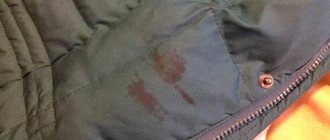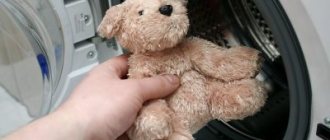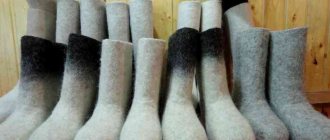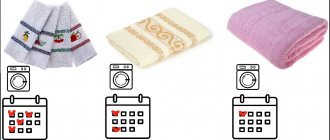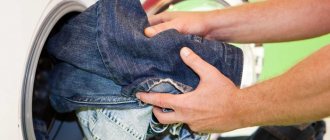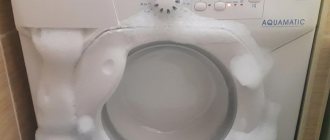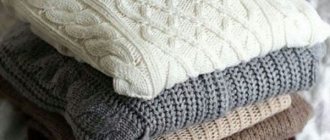A medical bandage is a special device for fixing a certain part of the body after surgery or treatment, as well as during pregnancy and after childbirth. The textile product is made of synthetic fiber, so the bandage can be washed in a machine or by hand. To ensure that the elastic fabric does not lose its shock-absorbing properties during the cleaning process and that the fixing bandage continues to perform its therapeutic and prophylactic functions, you must follow the washing rules recommended by doctors.
Can bandages be washed?
Postoperative
It is an elastic bandage. The product needs care to prevent the destruction of latex threads. Cleaning is carried out as soon as it gets dirty.
Orthopedic
Orthopedic bandages are soft and reinforced with anatomical stiffeners. The product can be washed by removing the stiffeners. If this is not possible, then wash them by hand without removing them.
Before washing, fasteners on adhesive tapes are pressed tightly so that they do not lose their functionality.
Before first use, hand washing is recommended at temperatures up to 40 degrees.
For pregnant
You need to care for the bandage daily by wiping it with a damp soft cloth. Washing is recommended at least once a week.
What to do with feces?
Feces during breastfeeding:
You don't need to do anything. Breastfeeding feces are 100% organic and will be removed during the initial rinse. If there is a lot of feces, it would be wiser to flush the contents down the toilet or sink first.
Formula-fed feces and solid feces: As with all diapers, when changing a reusable diaper, remove as much solid material as possible (throw into the toilet or trash can).
*Did you know that even disposable diaper manufacturers remind you on the packaging that all solids must be disposed of in the toilet before disposing of the diaper? Our landfills are NOT designed to handle human feces. Dispose of feces in the sewer (through the toilet)!
Selection of detergents
Manufacturers allow compression products to be washed, but only in compliance with the rules.
Aggressive detergents can damage the fastening elements.
Choose gentle organic and hypoallergenic products, baby soap or gel.
Can not use:
- bleach;
- stain remover;
- solvent;
- air conditioner;
- regular washing powder;
- dry cleaning.
Laundry soap will help get rid of heavy stains. Procedure:
- Soak the product in warm water for 20 minutes.
- Lather the stain with soap and wait a few minutes.
- Gently scrub the dirty area.
- Rinse in cool water.
- Squeeze without using physical force.
Recommendations for detergents:
▪ Focus not on the name of the product, but on its ingredients. Remember that positioning a product as “for children” does not automatically make it safe for use.
▪ Make sure that the composition does not contain optical, chlorine bleaches, or fabric softeners. 3. Avoid powders with high soap content as this will clog the fibers of the wicking layer, making the diaper unusable.
▪ Use one third of the recommended amount of detergent. If diapers are heavily soiled, consider rinsing more thoroughly before washing rather than increasing the dose of detergent.
▪ Do not use essential oils, conditioners or other fabric softeners or fragrances.
▪ To disinfect diapers, it is enough to use the recommended washing and drying mode. Do not add vinegar, chemical antibacterial agents or tablets when washing.
If you have questions about washing instructions, please seek competent advice from qualified advisors
In the typewriter
Before washing, read the manufacturer's care recommendations. The information must be on a label on the inside of the product or on the packaging.
Washing postoperative bandage in a machine is possible if:
- water temperature no higher than 30 degrees;
- delicate mode is set;
- the number of revolutions during spinning is minimal;
- The extra rinse function is not used.
The orthopedic washed unless otherwise specified by the manufacturer. The parameters are:
- delicate or hand wash;
- temperature not higher than 40 degrees;
- Spin is disabled.
maternity can be washed in a washing machine
- Set to delicate mode.
- Set the temperature to 30 degrees.
- Do not turn on the additional rinse mode.
- Set the spin to minimum speed or turn it off.
How to wash a bandage: for pregnant women and after surgery?
Pregnancy is the best state of a woman. There is no happier time. After all, what could be more important than the birth of a new life.
A growing baby puts a lot of pressure on all the internal organs of a woman. It is very difficult for the body to cope with such loads. To alleviate a woman’s condition, experts recommend using a bandage.
A bandage is a special device to support the mother’s body and facilitate the period of bearing a baby.
There are 3 main types of products:
- Prenatal. Used during pregnancy.
- Postpartum. It is recommended to wear it for several weeks after giving birth.
- Combined. Can be used both during pregnancy and after childbirth.
Like other items, the bandage is susceptible to contamination. However, it is necessary to follow more carefully the basic methods of caring for the product and use only gentle detergents.
It is worth remembering that the comfort of not only the mother, but also the child depends on a properly cleaned bandage.
Features of care:
- Don't wear the brace all the time. Limit yourself to a few hours a day.
- Choose the right type of bandage.
- Wipe the bandage daily with a soft, damp cloth.
- Wash the bandage at least once a week.
How to wash a maternity bandage by hand:
- Clean the product from dust using a soft brush or damp cloth.
- Fill a basin with warm water and dilute the detergent in it. Choose a hypoallergenic detergent for washing children's clothes. Before use, check your allergic reaction to it. To do this, dilute a small amount of the product in water and apply to the fabric. Place the fabric on the crook of your elbow and press for a few seconds. Observe for 3-4 hours. If irritation and redness do not appear on the bend of the elbow, this product can be used to wash the bandage.
- Place the bandage in water and soak for half an hour.
- If the bandage is heavily soiled, rub it with baby soap and leave for half an hour.
- Wash the product carefully, being careful not to bend or twist it.
- Rinse the bandage in running water until it becomes clear.
- Gently wring out the product.
- Hang the bandage on a clothesline until completely dry. Do not place it in direct sunlight.
We wash the bandage in the washing machine
Many people are wondering whether the bandage can be washed in a washing machine. To prevent it from becoming deformed during washing, it is recommended to follow the following rules:
- Set the “delicate wash” mode.
- Heating temperature – up to 30 degrees
- Choose the minimum speed.
- Do not turn on the extra rinse mode.
- Use detergent to wash baby clothes.
- Do not dry the bandage on a radiator or heated towel rail. It is recommended to dry it on a clothesline in a room with natural ventilation.
A bandage is necessary not only for pregnant women and women who have given birth. In many cases, after operations, doctors recommend that their patients wear a postoperative bandage. It allows you to significantly reduce the time required for rehabilitation.
This type of bandage also requires constant care. Let's look at the basic recommendations on how to wash a post-operative bandage:
- To wash it by hand, use laundry soap.
- Soak the bandage in warm water for 20 minutes, then scrub the contaminated areas well with soap.
- Gently rinse the product in cool water.
- Do not twist or bend the bandage.
- Lightly wring out the bandage and leave it on the clothesline to dry completely.
We wash the postoperative bandage in the washing machine:
- Select “hand wash” mode
- Set the temperature to 30 degrees.
- Set the minimum spin speed
- Blot the clean bandage with a terry towel and leave it to dry naturally on a clothesline in a well-ventilated area.
How to remove stains from a corset
If there are stains on the corset, before soaking and the main wash you need to rub the stains with laundry soap. It will not only clean, but also disinfect the fabric. Instead of laundry soap, you can take special “Antipyatin” soap. This is an inexpensive, accessible and safe product that easily removes various types of contaminants. It does not cause allergies and is safe for children.
Gently rub the soap onto the stain, but do not spread the soap suds. Leave the product like this until it dries completely and then wash it. You can also use folk remedies. Do not use acetone and gasoline, potassium permanganate, ammonia or medical alcohol, glycerin, or chlorine-containing bleaches to remove stains!
Coffee and blood stains, shiny and scorched marks from the iron will be removed by hydrogen peroxide. Soak a cotton pad in the mixture and gently soak the stain, trying not to go beyond the edges so as not to rub the stain even more. We remove tea stains using citric acid dissolved in water in a ratio of 1 to 10.
The selected product needs to be treated only on the stain, without going beyond its boundaries. Otherwise, you will only smear the dirt. Leave the treated item for a few minutes and then wash.
Delicate materials and decor
For corsets made of silk and satin, as well as for products with beads, rhinestones and other decorative elements, it is advisable to use only surface cleaning without soaking and classic washing. To do this, use a neutral-colored liquid detergent. This could be a soap solution, shampoo or gel for delicate items.
Dissolve the composition in water and apply to the surface of the product, then brush and rinse in cool, clean water. After the procedure, let the water drain and wrap it in a terry towel to absorb the remaining moisture. Then we lay it out on a dry towel or hang it, shape it into the desired shape with our hands and leave it to dry completely at room temperature.
Since beads and similar jewelry fade in water, to preserve color and brightness after washing, wipe the beads with a vinegar solution. To do this, mix half a tablespoon of lukewarm water and two tablespoons of vinegar. In addition, before washing, you can carefully remove the jewelry, and after drying, attach it back to the product.
How to wash a camel wool belt?
A belt made of 100% camel wool protects and warms the lower back well. Velcro makes it easy to put on and take off the belt and provides free adjustment of the length of the belt. Washing and care instructions: Dry clean or hand wash with warm water and a special mild detergent.
Interesting materials:
Creatine universal how to take? What is defragmentation? How are maternity payments calculated? When are maternity benefits paid? What percentage of children's sick leave is paid? How much can you lose on a buckwheat diet? Dns server is not responding how to fix it? Until what age do they serve in the US Army? What is the retention period before liquidation of the organization? How to calculate the income of an individual entrepreneur?
General recommendations
- The underwire corset can only be washed by hand. Machine washing, even in a gentle, delicate or gentle mode, will irreversibly damage the product;
- Some types of corsets can be washed in a washing machine with a gentle wash program. It is advisable to place the products in a special separate bag;
- Be especially careful when washing models with decorations, such as beads, beads, rhinestones, etc. Experts advise tearing off such elements before water procedures, and then sewing or gluing them back, otherwise they may fall off, get damaged or get lost during the washing process;
- It is forbidden to iron or wash items at high temperatures, otherwise the corset will shrink, fade or become deformed. And plastic bones will simply melt or break;
- Don't soak clothes for too long. 15-30 minutes is enough. And do not use powdered detergents, aggressive or chlorine-containing compounds for washing, otherwise they will ruin the material;
- You cannot squeeze such products. After washing, leave the corset to drain, and then dry it in a terry towel and dry it at room temperature;
- Dry items in a well-ventilated area or at room temperature, away from direct sunlight, radiators and radiators;
- Don't wash your corsets too often. For care, it is enough to air the product after each wear and then put it in the closet.
How to put on and tighten a corset correctly
- Thread the ribbon through the top two holes. The ends of the lacing should be located at the same distance;
- Take the lacing from the right side and thread it from above into the next free hole on the left side of the product;
- Do the same with the left ribbon, threading it through the right side. Lacing is formed crosswise, and the ribbons are inside;
- Pass the right braid through the hole again from the left side from the bottom up, from the inside to the front. Do the same with the left lace. It turns out there are already two X's, one inside and the other outside;
- Repeat steps 2-4 until the ribbons reach waist level, where you need to make loops that tighten the corset;
- We place the right cord in the hole located below on the same right side. We thread the braid from top to bottom, from the outside to the inside;
- Do the same with the left ribbon. Loops are formed to tighten the bodice;
- After the loops, repeat steps 2-4 until you reach the bottom level. Distribute the tape evenly so that there is a gap of about ten centimeters between the right and left parts of the product. Then we tighten the corset.

